University Report: Leisure Shopping and Tourist Purchase Behavior
VerifiedAdded on 2020/04/07
|15
|3596
|121
Report
AI Summary
This report delves into the complexities of leisure shopping, particularly within rural tourism contexts. It investigates the challenges faced by retailers in understanding and catering to the purchase behaviors of tourists, both domestic and international. The study poses three key research questions: why visitors may not buy local products, the types of products tourists prefer, and the socio-demographic profiles of local product purchasers. A quantitative sampling method was employed in a cultural village in Indonesia to gather data on tourist shopping habits. The report reviews literature on souvenir design, pricing, and quality, and analyzes variables like ambiance, price, product variety, and retailer-customer relationships. Findings highlight the influence of factors such as atmosphere, product uniqueness, and pricing on tourist buying behavior. The analysis reveals that tourists often seek souvenirs with a distinctive local touch, including clothes, handicrafts, and local foods, and that socio-demographic factors significantly shape purchasing patterns. The report underscores the importance of market segmentation and understanding tourist preferences to improve the leisure shopping experience and boost local economies. The report concludes with recommendations for retailers to enhance their offerings and address challenges related to tourist satisfaction and product desirability.
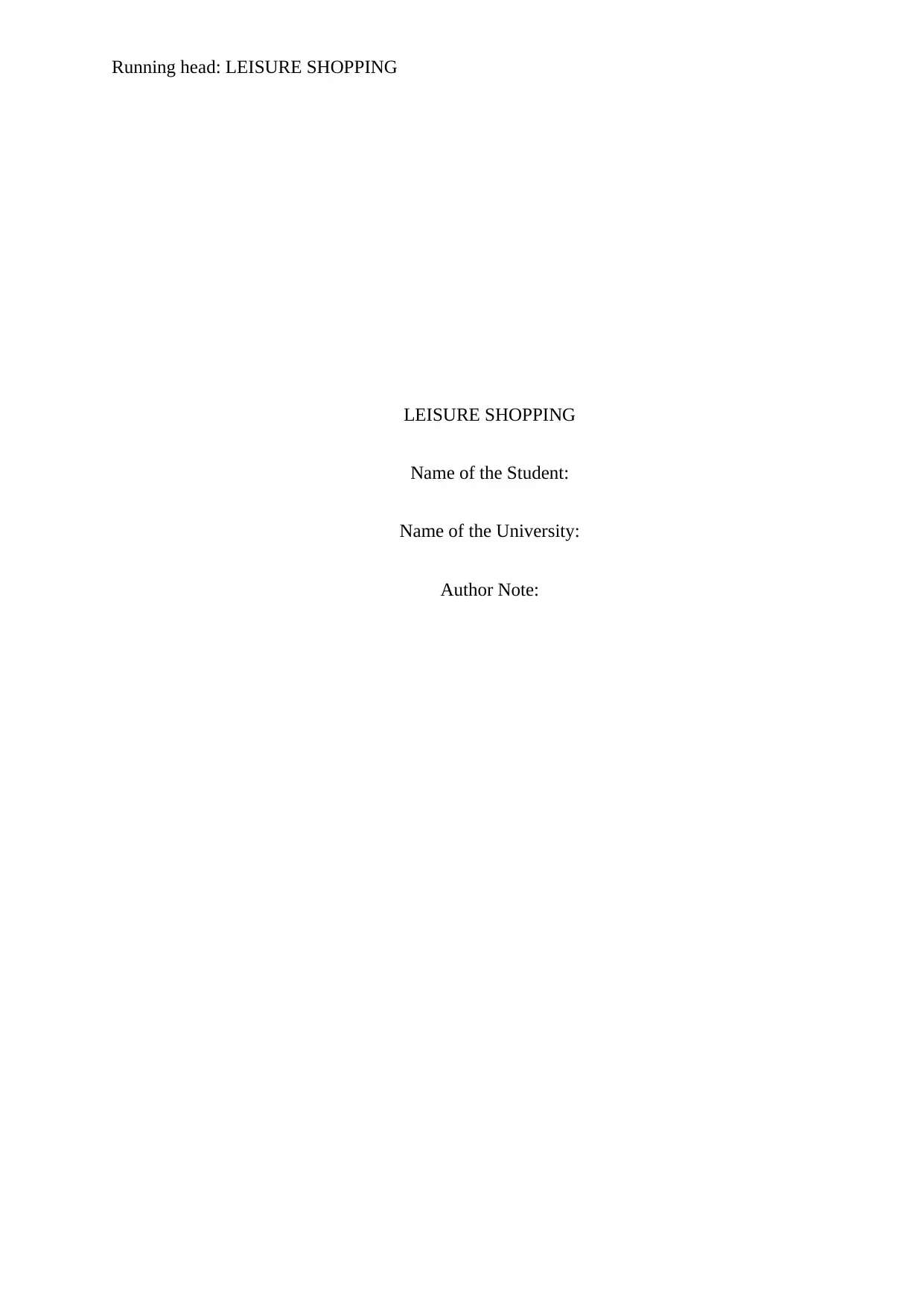
Running head: LEISURE SHOPPING
LEISURE SHOPPING
Name of the Student:
Name of the University:
Author Note:
LEISURE SHOPPING
Name of the Student:
Name of the University:
Author Note:
Paraphrase This Document
Need a fresh take? Get an instant paraphrase of this document with our AI Paraphraser
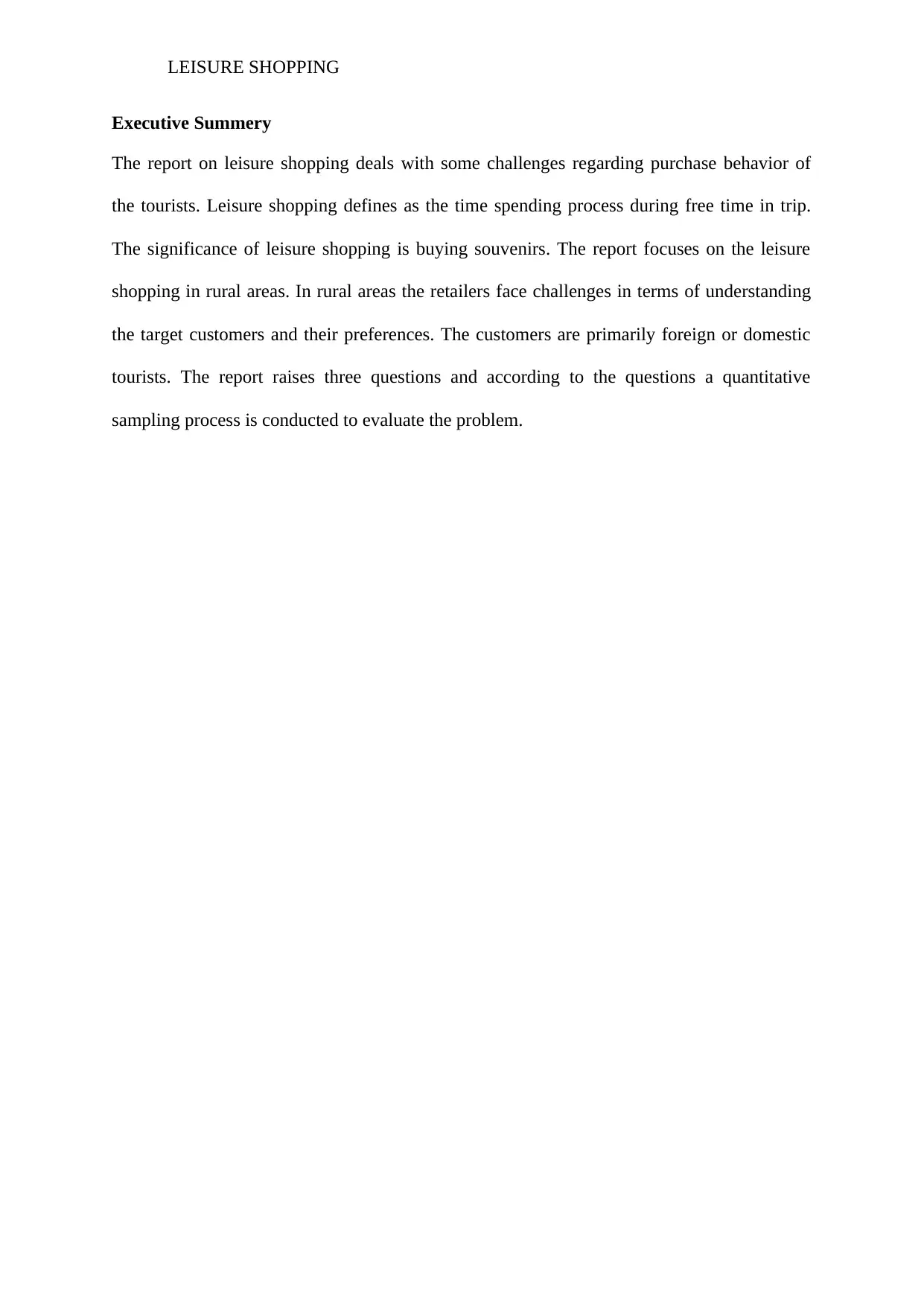
LEISURE SHOPPING
Executive Summery
The report on leisure shopping deals with some challenges regarding purchase behavior of
the tourists. Leisure shopping defines as the time spending process during free time in trip.
The significance of leisure shopping is buying souvenirs. The report focuses on the leisure
shopping in rural areas. In rural areas the retailers face challenges in terms of understanding
the target customers and their preferences. The customers are primarily foreign or domestic
tourists. The report raises three questions and according to the questions a quantitative
sampling process is conducted to evaluate the problem.
Executive Summery
The report on leisure shopping deals with some challenges regarding purchase behavior of
the tourists. Leisure shopping defines as the time spending process during free time in trip.
The significance of leisure shopping is buying souvenirs. The report focuses on the leisure
shopping in rural areas. In rural areas the retailers face challenges in terms of understanding
the target customers and their preferences. The customers are primarily foreign or domestic
tourists. The report raises three questions and according to the questions a quantitative
sampling process is conducted to evaluate the problem.
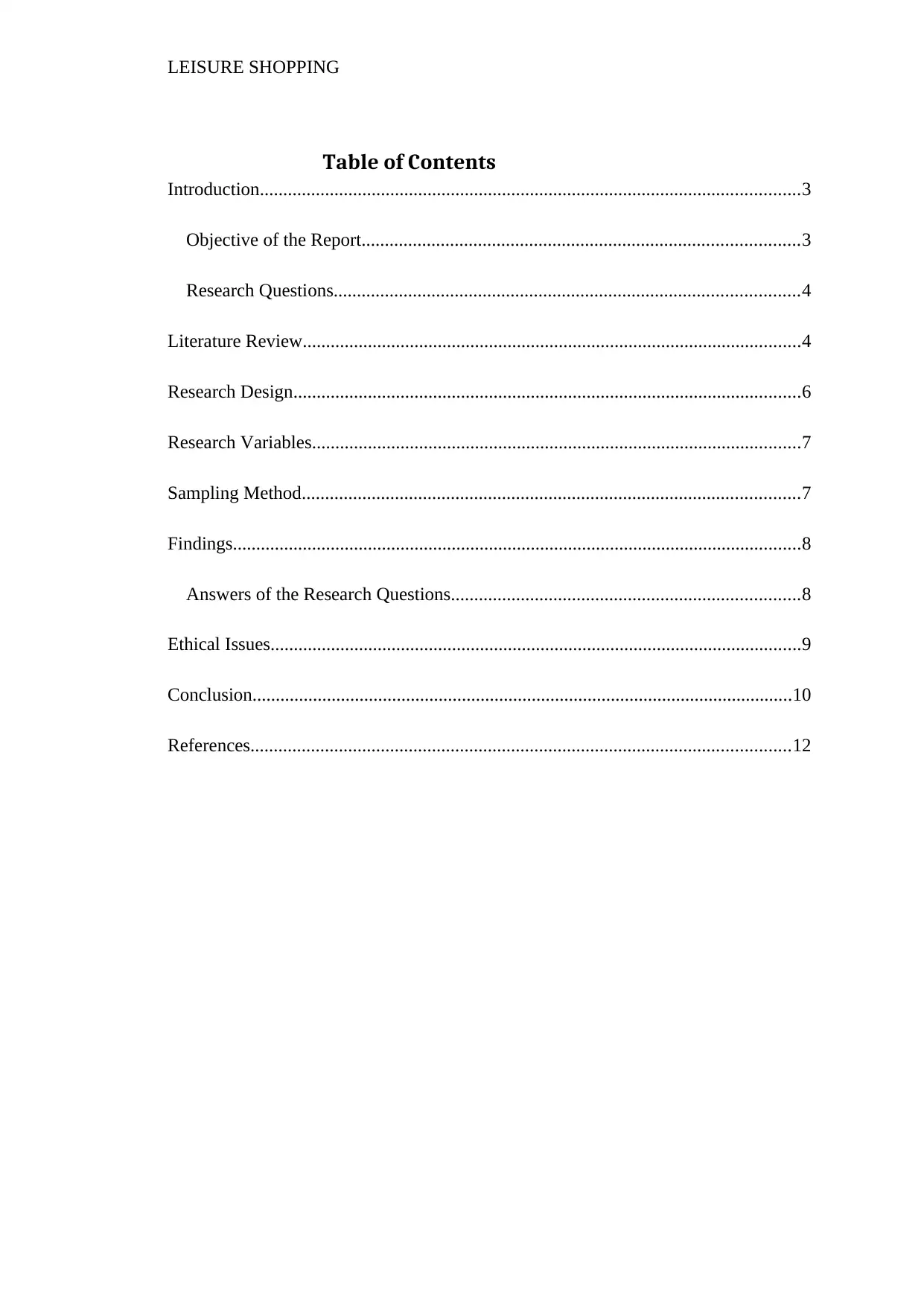
LEISURE SHOPPING
Table of Contents
Introduction....................................................................................................................3
Objective of the Report..............................................................................................3
Research Questions....................................................................................................4
Literature Review...........................................................................................................4
Research Design.............................................................................................................6
Research Variables.........................................................................................................7
Sampling Method...........................................................................................................7
Findings..........................................................................................................................8
Answers of the Research Questions...........................................................................8
Ethical Issues..................................................................................................................9
Conclusion....................................................................................................................10
References....................................................................................................................12
Table of Contents
Introduction....................................................................................................................3
Objective of the Report..............................................................................................3
Research Questions....................................................................................................4
Literature Review...........................................................................................................4
Research Design.............................................................................................................6
Research Variables.........................................................................................................7
Sampling Method...........................................................................................................7
Findings..........................................................................................................................8
Answers of the Research Questions...........................................................................8
Ethical Issues..................................................................................................................9
Conclusion....................................................................................................................10
References....................................................................................................................12
⊘ This is a preview!⊘
Do you want full access?
Subscribe today to unlock all pages.

Trusted by 1+ million students worldwide
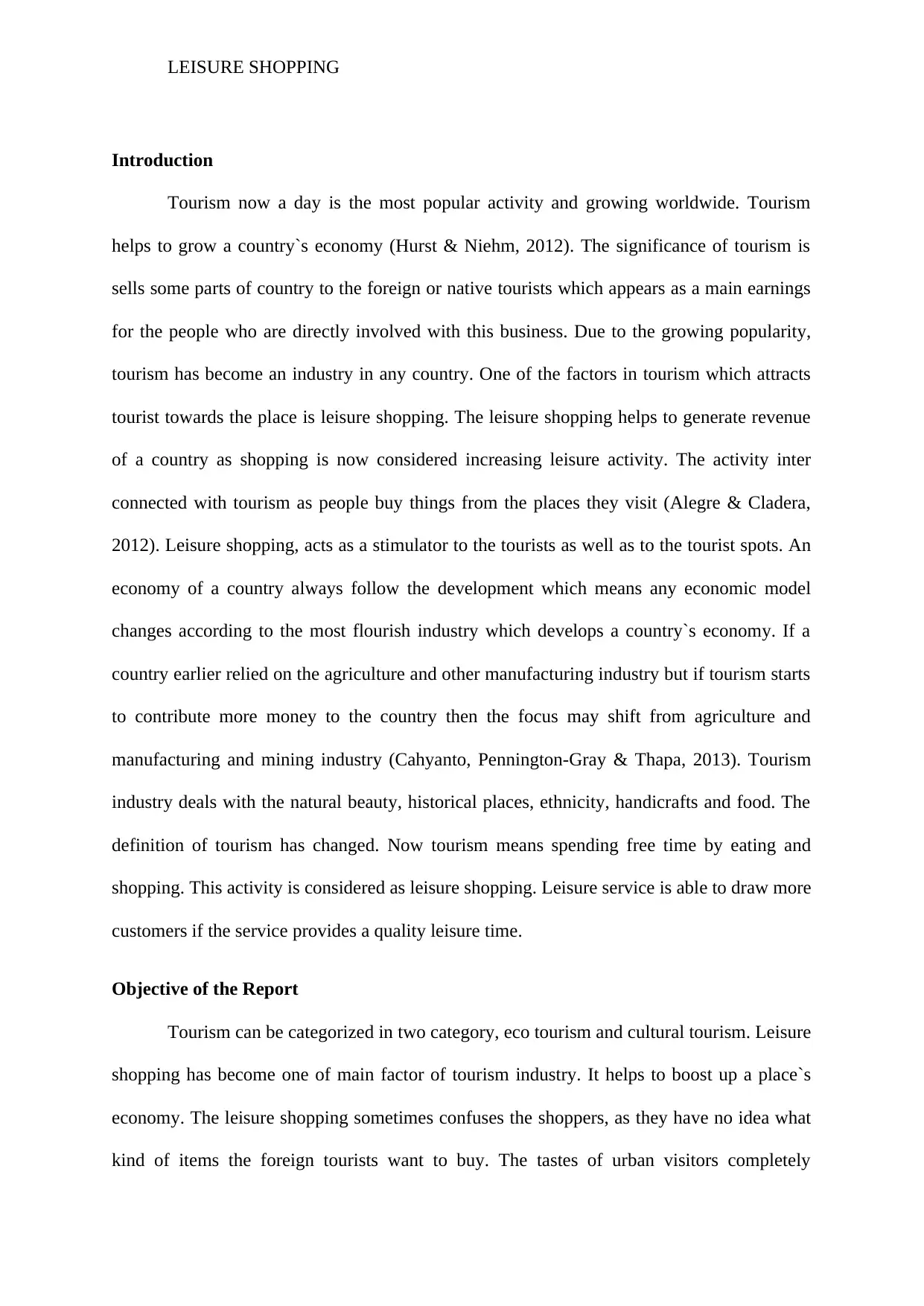
LEISURE SHOPPING
Introduction
Tourism now a day is the most popular activity and growing worldwide. Tourism
helps to grow a country`s economy (Hurst & Niehm, 2012). The significance of tourism is
sells some parts of country to the foreign or native tourists which appears as a main earnings
for the people who are directly involved with this business. Due to the growing popularity,
tourism has become an industry in any country. One of the factors in tourism which attracts
tourist towards the place is leisure shopping. The leisure shopping helps to generate revenue
of a country as shopping is now considered increasing leisure activity. The activity inter
connected with tourism as people buy things from the places they visit (Alegre & Cladera,
2012). Leisure shopping, acts as a stimulator to the tourists as well as to the tourist spots. An
economy of a country always follow the development which means any economic model
changes according to the most flourish industry which develops a country`s economy. If a
country earlier relied on the agriculture and other manufacturing industry but if tourism starts
to contribute more money to the country then the focus may shift from agriculture and
manufacturing and mining industry (Cahyanto, Pennington-Gray & Thapa, 2013). Tourism
industry deals with the natural beauty, historical places, ethnicity, handicrafts and food. The
definition of tourism has changed. Now tourism means spending free time by eating and
shopping. This activity is considered as leisure shopping. Leisure service is able to draw more
customers if the service provides a quality leisure time.
Objective of the Report
Tourism can be categorized in two category, eco tourism and cultural tourism. Leisure
shopping has become one of main factor of tourism industry. It helps to boost up a place`s
economy. The leisure shopping sometimes confuses the shoppers, as they have no idea what
kind of items the foreign tourists want to buy. The tastes of urban visitors completely
Introduction
Tourism now a day is the most popular activity and growing worldwide. Tourism
helps to grow a country`s economy (Hurst & Niehm, 2012). The significance of tourism is
sells some parts of country to the foreign or native tourists which appears as a main earnings
for the people who are directly involved with this business. Due to the growing popularity,
tourism has become an industry in any country. One of the factors in tourism which attracts
tourist towards the place is leisure shopping. The leisure shopping helps to generate revenue
of a country as shopping is now considered increasing leisure activity. The activity inter
connected with tourism as people buy things from the places they visit (Alegre & Cladera,
2012). Leisure shopping, acts as a stimulator to the tourists as well as to the tourist spots. An
economy of a country always follow the development which means any economic model
changes according to the most flourish industry which develops a country`s economy. If a
country earlier relied on the agriculture and other manufacturing industry but if tourism starts
to contribute more money to the country then the focus may shift from agriculture and
manufacturing and mining industry (Cahyanto, Pennington-Gray & Thapa, 2013). Tourism
industry deals with the natural beauty, historical places, ethnicity, handicrafts and food. The
definition of tourism has changed. Now tourism means spending free time by eating and
shopping. This activity is considered as leisure shopping. Leisure service is able to draw more
customers if the service provides a quality leisure time.
Objective of the Report
Tourism can be categorized in two category, eco tourism and cultural tourism. Leisure
shopping has become one of main factor of tourism industry. It helps to boost up a place`s
economy. The leisure shopping sometimes confuses the shoppers, as they have no idea what
kind of items the foreign tourists want to buy. The tastes of urban visitors completely
Paraphrase This Document
Need a fresh take? Get an instant paraphrase of this document with our AI Paraphraser
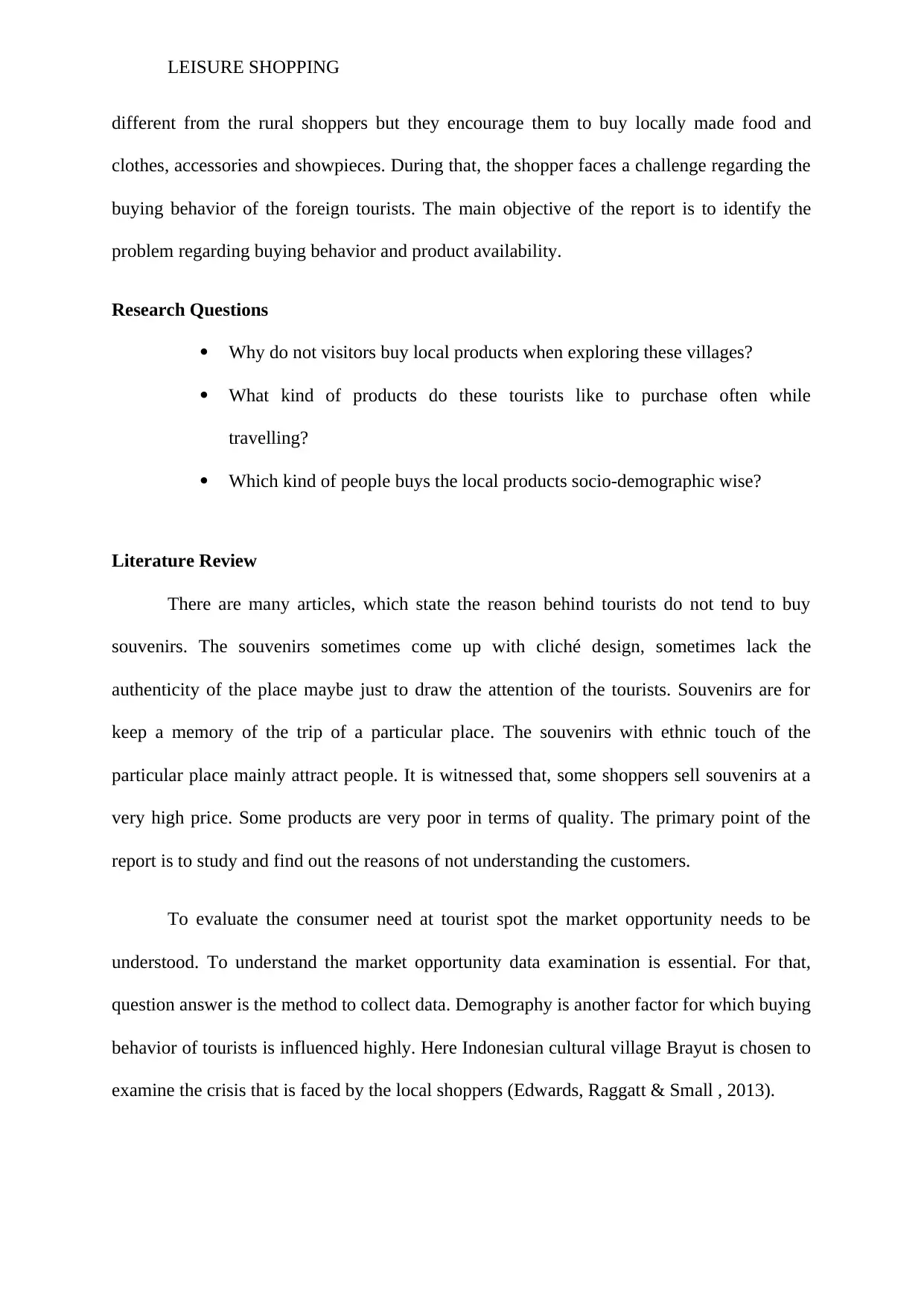
LEISURE SHOPPING
different from the rural shoppers but they encourage them to buy locally made food and
clothes, accessories and showpieces. During that, the shopper faces a challenge regarding the
buying behavior of the foreign tourists. The main objective of the report is to identify the
problem regarding buying behavior and product availability.
Research Questions
Why do not visitors buy local products when exploring these villages?
What kind of products do these tourists like to purchase often while
travelling?
Which kind of people buys the local products socio-demographic wise?
Literature Review
There are many articles, which state the reason behind tourists do not tend to buy
souvenirs. The souvenirs sometimes come up with cliché design, sometimes lack the
authenticity of the place maybe just to draw the attention of the tourists. Souvenirs are for
keep a memory of the trip of a particular place. The souvenirs with ethnic touch of the
particular place mainly attract people. It is witnessed that, some shoppers sell souvenirs at a
very high price. Some products are very poor in terms of quality. The primary point of the
report is to study and find out the reasons of not understanding the customers.
To evaluate the consumer need at tourist spot the market opportunity needs to be
understood. To understand the market opportunity data examination is essential. For that,
question answer is the method to collect data. Demography is another factor for which buying
behavior of tourists is influenced highly. Here Indonesian cultural village Brayut is chosen to
examine the crisis that is faced by the local shoppers (Edwards, Raggatt & Small , 2013).
different from the rural shoppers but they encourage them to buy locally made food and
clothes, accessories and showpieces. During that, the shopper faces a challenge regarding the
buying behavior of the foreign tourists. The main objective of the report is to identify the
problem regarding buying behavior and product availability.
Research Questions
Why do not visitors buy local products when exploring these villages?
What kind of products do these tourists like to purchase often while
travelling?
Which kind of people buys the local products socio-demographic wise?
Literature Review
There are many articles, which state the reason behind tourists do not tend to buy
souvenirs. The souvenirs sometimes come up with cliché design, sometimes lack the
authenticity of the place maybe just to draw the attention of the tourists. Souvenirs are for
keep a memory of the trip of a particular place. The souvenirs with ethnic touch of the
particular place mainly attract people. It is witnessed that, some shoppers sell souvenirs at a
very high price. Some products are very poor in terms of quality. The primary point of the
report is to study and find out the reasons of not understanding the customers.
To evaluate the consumer need at tourist spot the market opportunity needs to be
understood. To understand the market opportunity data examination is essential. For that,
question answer is the method to collect data. Demography is another factor for which buying
behavior of tourists is influenced highly. Here Indonesian cultural village Brayut is chosen to
examine the crisis that is faced by the local shoppers (Edwards, Raggatt & Small , 2013).
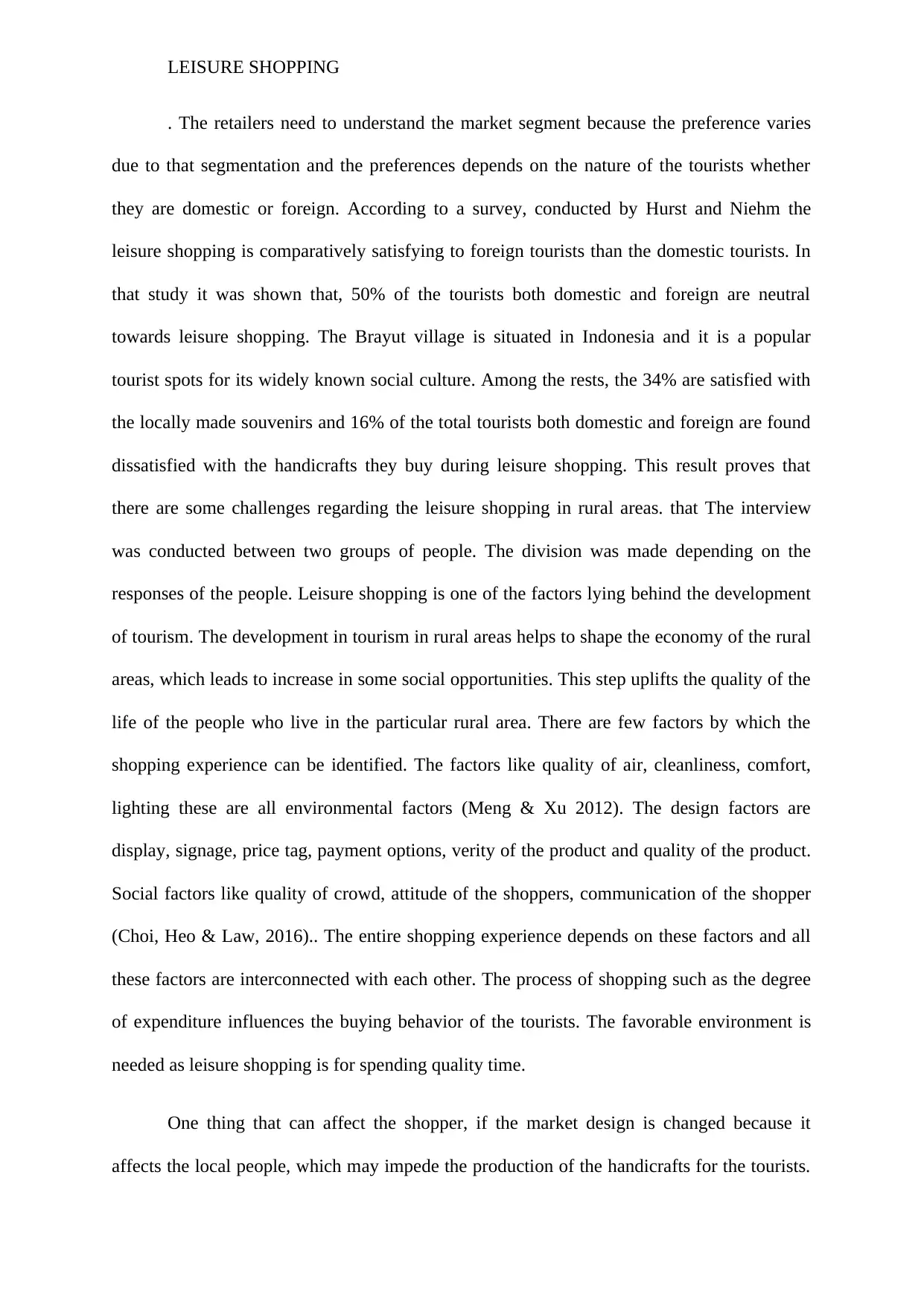
LEISURE SHOPPING
. The retailers need to understand the market segment because the preference varies
due to that segmentation and the preferences depends on the nature of the tourists whether
they are domestic or foreign. According to a survey, conducted by Hurst and Niehm the
leisure shopping is comparatively satisfying to foreign tourists than the domestic tourists. In
that study it was shown that, 50% of the tourists both domestic and foreign are neutral
towards leisure shopping. The Brayut village is situated in Indonesia and it is a popular
tourist spots for its widely known social culture. Among the rests, the 34% are satisfied with
the locally made souvenirs and 16% of the total tourists both domestic and foreign are found
dissatisfied with the handicrafts they buy during leisure shopping. This result proves that
there are some challenges regarding the leisure shopping in rural areas. that The interview
was conducted between two groups of people. The division was made depending on the
responses of the people. Leisure shopping is one of the factors lying behind the development
of tourism. The development in tourism in rural areas helps to shape the economy of the rural
areas, which leads to increase in some social opportunities. This step uplifts the quality of the
life of the people who live in the particular rural area. There are few factors by which the
shopping experience can be identified. The factors like quality of air, cleanliness, comfort,
lighting these are all environmental factors (Meng & Xu 2012). The design factors are
display, signage, price tag, payment options, verity of the product and quality of the product.
Social factors like quality of crowd, attitude of the shoppers, communication of the shopper
(Choi, Heo & Law, 2016).. The entire shopping experience depends on these factors and all
these factors are interconnected with each other. The process of shopping such as the degree
of expenditure influences the buying behavior of the tourists. The favorable environment is
needed as leisure shopping is for spending quality time.
One thing that can affect the shopper, if the market design is changed because it
affects the local people, which may impede the production of the handicrafts for the tourists.
. The retailers need to understand the market segment because the preference varies
due to that segmentation and the preferences depends on the nature of the tourists whether
they are domestic or foreign. According to a survey, conducted by Hurst and Niehm the
leisure shopping is comparatively satisfying to foreign tourists than the domestic tourists. In
that study it was shown that, 50% of the tourists both domestic and foreign are neutral
towards leisure shopping. The Brayut village is situated in Indonesia and it is a popular
tourist spots for its widely known social culture. Among the rests, the 34% are satisfied with
the locally made souvenirs and 16% of the total tourists both domestic and foreign are found
dissatisfied with the handicrafts they buy during leisure shopping. This result proves that
there are some challenges regarding the leisure shopping in rural areas. that The interview
was conducted between two groups of people. The division was made depending on the
responses of the people. Leisure shopping is one of the factors lying behind the development
of tourism. The development in tourism in rural areas helps to shape the economy of the rural
areas, which leads to increase in some social opportunities. This step uplifts the quality of the
life of the people who live in the particular rural area. There are few factors by which the
shopping experience can be identified. The factors like quality of air, cleanliness, comfort,
lighting these are all environmental factors (Meng & Xu 2012). The design factors are
display, signage, price tag, payment options, verity of the product and quality of the product.
Social factors like quality of crowd, attitude of the shoppers, communication of the shopper
(Choi, Heo & Law, 2016).. The entire shopping experience depends on these factors and all
these factors are interconnected with each other. The process of shopping such as the degree
of expenditure influences the buying behavior of the tourists. The favorable environment is
needed as leisure shopping is for spending quality time.
One thing that can affect the shopper, if the market design is changed because it
affects the local people, which may impede the production of the handicrafts for the tourists.
⊘ This is a preview!⊘
Do you want full access?
Subscribe today to unlock all pages.

Trusted by 1+ million students worldwide
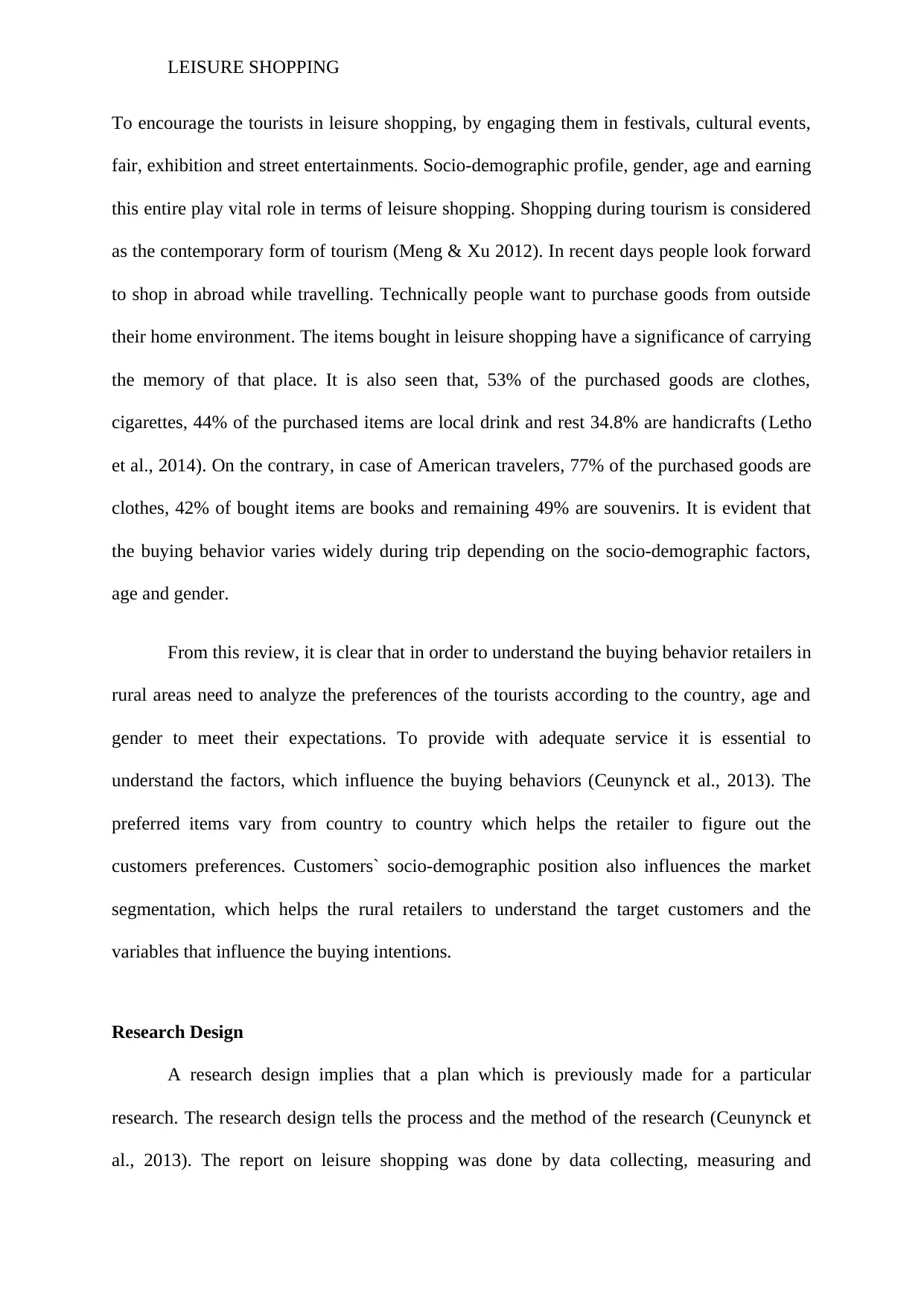
LEISURE SHOPPING
To encourage the tourists in leisure shopping, by engaging them in festivals, cultural events,
fair, exhibition and street entertainments. Socio-demographic profile, gender, age and earning
this entire play vital role in terms of leisure shopping. Shopping during tourism is considered
as the contemporary form of tourism (Meng & Xu 2012). In recent days people look forward
to shop in abroad while travelling. Technically people want to purchase goods from outside
their home environment. The items bought in leisure shopping have a significance of carrying
the memory of that place. It is also seen that, 53% of the purchased goods are clothes,
cigarettes, 44% of the purchased items are local drink and rest 34.8% are handicrafts (Letho
et al., 2014). On the contrary, in case of American travelers, 77% of the purchased goods are
clothes, 42% of bought items are books and remaining 49% are souvenirs. It is evident that
the buying behavior varies widely during trip depending on the socio-demographic factors,
age and gender.
From this review, it is clear that in order to understand the buying behavior retailers in
rural areas need to analyze the preferences of the tourists according to the country, age and
gender to meet their expectations. To provide with adequate service it is essential to
understand the factors, which influence the buying behaviors (Ceunynck et al., 2013). The
preferred items vary from country to country which helps the retailer to figure out the
customers preferences. Customers` socio-demographic position also influences the market
segmentation, which helps the rural retailers to understand the target customers and the
variables that influence the buying intentions.
Research Design
A research design implies that a plan which is previously made for a particular
research. The research design tells the process and the method of the research (Ceunynck et
al., 2013). The report on leisure shopping was done by data collecting, measuring and
To encourage the tourists in leisure shopping, by engaging them in festivals, cultural events,
fair, exhibition and street entertainments. Socio-demographic profile, gender, age and earning
this entire play vital role in terms of leisure shopping. Shopping during tourism is considered
as the contemporary form of tourism (Meng & Xu 2012). In recent days people look forward
to shop in abroad while travelling. Technically people want to purchase goods from outside
their home environment. The items bought in leisure shopping have a significance of carrying
the memory of that place. It is also seen that, 53% of the purchased goods are clothes,
cigarettes, 44% of the purchased items are local drink and rest 34.8% are handicrafts (Letho
et al., 2014). On the contrary, in case of American travelers, 77% of the purchased goods are
clothes, 42% of bought items are books and remaining 49% are souvenirs. It is evident that
the buying behavior varies widely during trip depending on the socio-demographic factors,
age and gender.
From this review, it is clear that in order to understand the buying behavior retailers in
rural areas need to analyze the preferences of the tourists according to the country, age and
gender to meet their expectations. To provide with adequate service it is essential to
understand the factors, which influence the buying behaviors (Ceunynck et al., 2013). The
preferred items vary from country to country which helps the retailer to figure out the
customers preferences. Customers` socio-demographic position also influences the market
segmentation, which helps the rural retailers to understand the target customers and the
variables that influence the buying intentions.
Research Design
A research design implies that a plan which is previously made for a particular
research. The research design tells the process and the method of the research (Ceunynck et
al., 2013). The report on leisure shopping was done by data collecting, measuring and
Paraphrase This Document
Need a fresh take? Get an instant paraphrase of this document with our AI Paraphraser
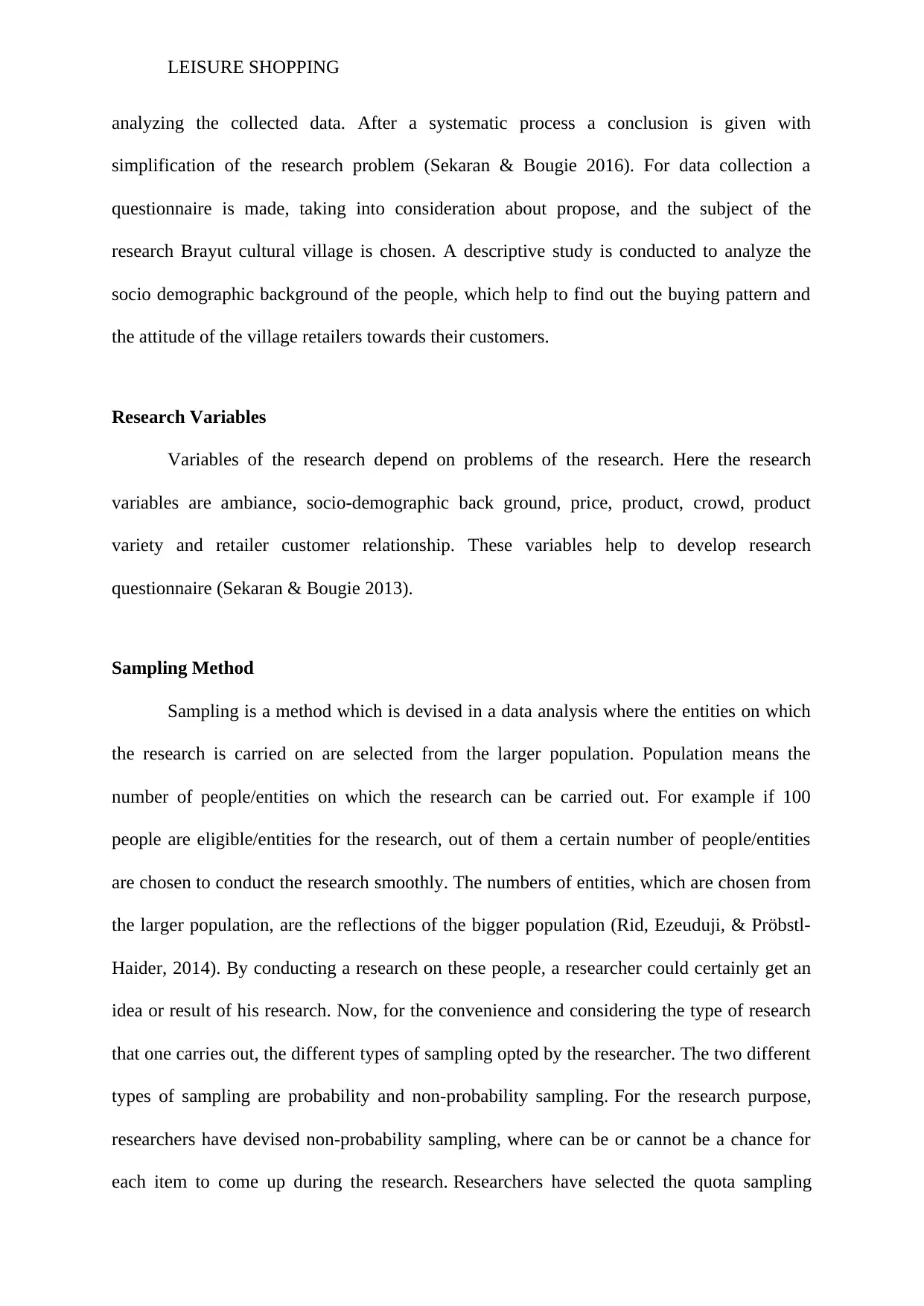
LEISURE SHOPPING
analyzing the collected data. After a systematic process a conclusion is given with
simplification of the research problem (Sekaran & Bougie 2016). For data collection a
questionnaire is made, taking into consideration about propose, and the subject of the
research Brayut cultural village is chosen. A descriptive study is conducted to analyze the
socio demographic background of the people, which help to find out the buying pattern and
the attitude of the village retailers towards their customers.
Research Variables
Variables of the research depend on problems of the research. Here the research
variables are ambiance, socio-demographic back ground, price, product, crowd, product
variety and retailer customer relationship. These variables help to develop research
questionnaire (Sekaran & Bougie 2013).
Sampling Method
Sampling is a method which is devised in a data analysis where the entities on which
the research is carried on are selected from the larger population. Population means the
number of people/entities on which the research can be carried out. For example if 100
people are eligible/entities for the research, out of them a certain number of people/entities
are chosen to conduct the research smoothly. The numbers of entities, which are chosen from
the larger population, are the reflections of the bigger population (Rid, Ezeuduji, & Pröbstl-
Haider, 2014). By conducting a research on these people, a researcher could certainly get an
idea or result of his research. Now, for the convenience and considering the type of research
that one carries out, the different types of sampling opted by the researcher. The two different
types of sampling are probability and non-probability sampling. For the research purpose,
researchers have devised non-probability sampling, where can be or cannot be a chance for
each item to come up during the research. Researchers have selected the quota sampling
analyzing the collected data. After a systematic process a conclusion is given with
simplification of the research problem (Sekaran & Bougie 2016). For data collection a
questionnaire is made, taking into consideration about propose, and the subject of the
research Brayut cultural village is chosen. A descriptive study is conducted to analyze the
socio demographic background of the people, which help to find out the buying pattern and
the attitude of the village retailers towards their customers.
Research Variables
Variables of the research depend on problems of the research. Here the research
variables are ambiance, socio-demographic back ground, price, product, crowd, product
variety and retailer customer relationship. These variables help to develop research
questionnaire (Sekaran & Bougie 2013).
Sampling Method
Sampling is a method which is devised in a data analysis where the entities on which
the research is carried on are selected from the larger population. Population means the
number of people/entities on which the research can be carried out. For example if 100
people are eligible/entities for the research, out of them a certain number of people/entities
are chosen to conduct the research smoothly. The numbers of entities, which are chosen from
the larger population, are the reflections of the bigger population (Rid, Ezeuduji, & Pröbstl-
Haider, 2014). By conducting a research on these people, a researcher could certainly get an
idea or result of his research. Now, for the convenience and considering the type of research
that one carries out, the different types of sampling opted by the researcher. The two different
types of sampling are probability and non-probability sampling. For the research purpose,
researchers have devised non-probability sampling, where can be or cannot be a chance for
each item to come up during the research. Researchers have selected the quota sampling
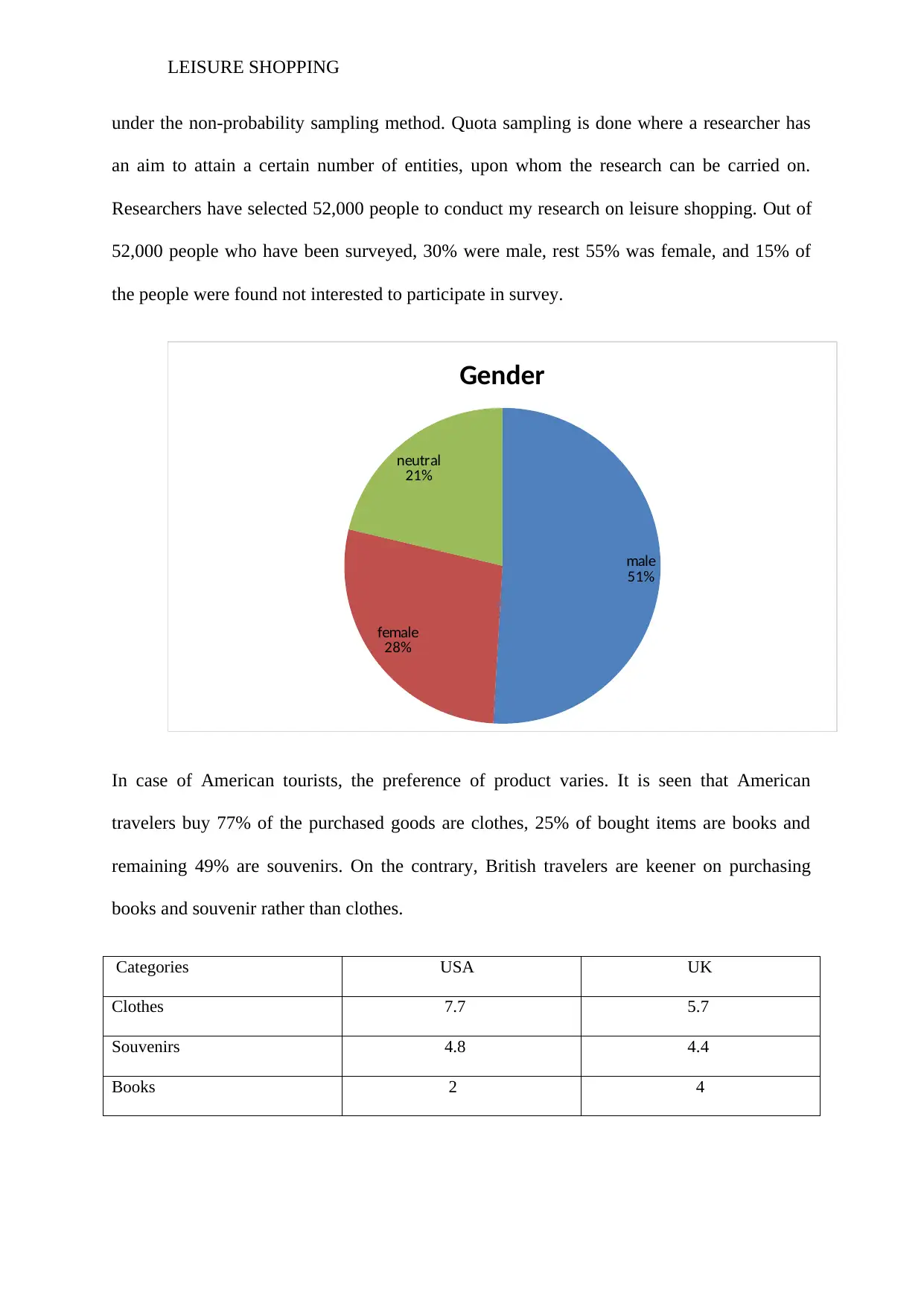
LEISURE SHOPPING
under the non-probability sampling method. Quota sampling is done where a researcher has
an aim to attain a certain number of entities, upon whom the research can be carried on.
Researchers have selected 52,000 people to conduct my research on leisure shopping. Out of
52,000 people who have been surveyed, 30% were male, rest 55% was female, and 15% of
the people were found not interested to participate in survey.
male
51%
female
28%
neutral
21%
Gender
In case of American tourists, the preference of product varies. It is seen that American
travelers buy 77% of the purchased goods are clothes, 25% of bought items are books and
remaining 49% are souvenirs. On the contrary, British travelers are keener on purchasing
books and souvenir rather than clothes.
Categories USA UK
Clothes 7.7 5.7
Souvenirs 4.8 4.4
Books 2 4
under the non-probability sampling method. Quota sampling is done where a researcher has
an aim to attain a certain number of entities, upon whom the research can be carried on.
Researchers have selected 52,000 people to conduct my research on leisure shopping. Out of
52,000 people who have been surveyed, 30% were male, rest 55% was female, and 15% of
the people were found not interested to participate in survey.
male
51%
female
28%
neutral
21%
Gender
In case of American tourists, the preference of product varies. It is seen that American
travelers buy 77% of the purchased goods are clothes, 25% of bought items are books and
remaining 49% are souvenirs. On the contrary, British travelers are keener on purchasing
books and souvenir rather than clothes.
Categories USA UK
Clothes 7.7 5.7
Souvenirs 4.8 4.4
Books 2 4
⊘ This is a preview!⊘
Do you want full access?
Subscribe today to unlock all pages.

Trusted by 1+ million students worldwide
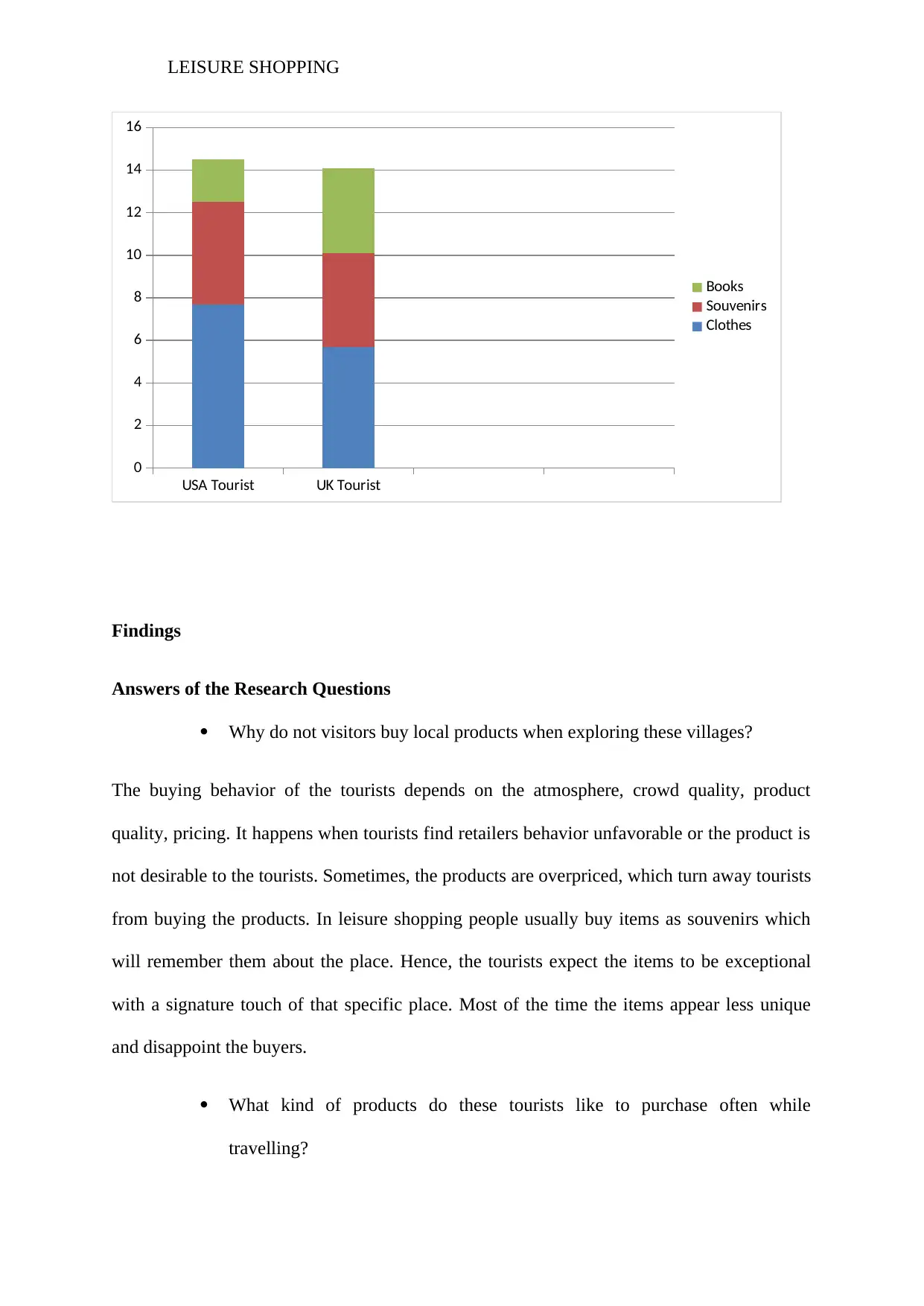
LEISURE SHOPPING
USA Tourist UK Tourist
0
2
4
6
8
10
12
14
16
Books
Souvenirs
Clothes
Findings
Answers of the Research Questions
Why do not visitors buy local products when exploring these villages?
The buying behavior of the tourists depends on the atmosphere, crowd quality, product
quality, pricing. It happens when tourists find retailers behavior unfavorable or the product is
not desirable to the tourists. Sometimes, the products are overpriced, which turn away tourists
from buying the products. In leisure shopping people usually buy items as souvenirs which
will remember them about the place. Hence, the tourists expect the items to be exceptional
with a signature touch of that specific place. Most of the time the items appear less unique
and disappoint the buyers.
What kind of products do these tourists like to purchase often while
travelling?
USA Tourist UK Tourist
0
2
4
6
8
10
12
14
16
Books
Souvenirs
Clothes
Findings
Answers of the Research Questions
Why do not visitors buy local products when exploring these villages?
The buying behavior of the tourists depends on the atmosphere, crowd quality, product
quality, pricing. It happens when tourists find retailers behavior unfavorable or the product is
not desirable to the tourists. Sometimes, the products are overpriced, which turn away tourists
from buying the products. In leisure shopping people usually buy items as souvenirs which
will remember them about the place. Hence, the tourists expect the items to be exceptional
with a signature touch of that specific place. Most of the time the items appear less unique
and disappoint the buyers.
What kind of products do these tourists like to purchase often while
travelling?
Paraphrase This Document
Need a fresh take? Get an instant paraphrase of this document with our AI Paraphraser
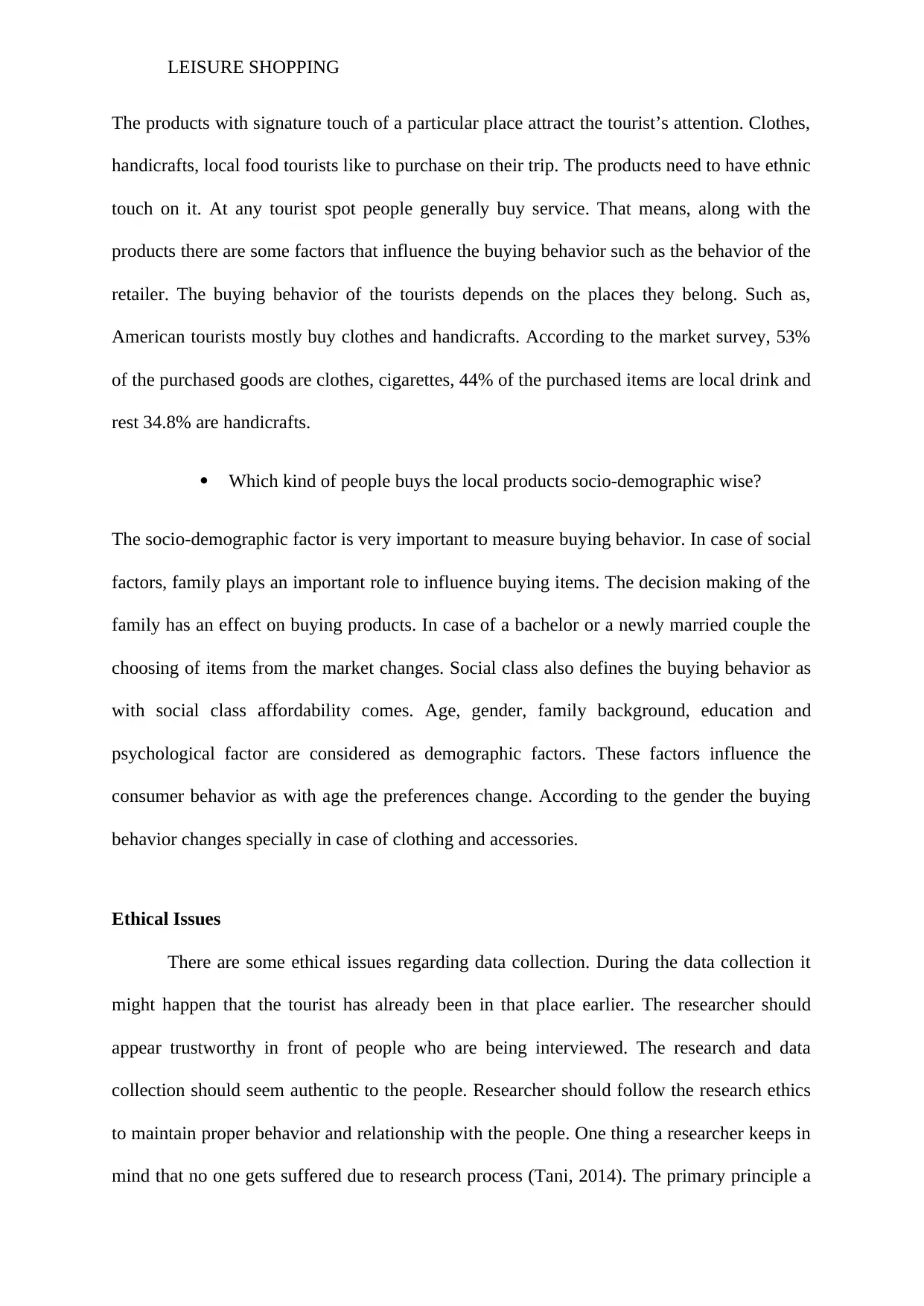
LEISURE SHOPPING
The products with signature touch of a particular place attract the tourist’s attention. Clothes,
handicrafts, local food tourists like to purchase on their trip. The products need to have ethnic
touch on it. At any tourist spot people generally buy service. That means, along with the
products there are some factors that influence the buying behavior such as the behavior of the
retailer. The buying behavior of the tourists depends on the places they belong. Such as,
American tourists mostly buy clothes and handicrafts. According to the market survey, 53%
of the purchased goods are clothes, cigarettes, 44% of the purchased items are local drink and
rest 34.8% are handicrafts.
Which kind of people buys the local products socio-demographic wise?
The socio-demographic factor is very important to measure buying behavior. In case of social
factors, family plays an important role to influence buying items. The decision making of the
family has an effect on buying products. In case of a bachelor or a newly married couple the
choosing of items from the market changes. Social class also defines the buying behavior as
with social class affordability comes. Age, gender, family background, education and
psychological factor are considered as demographic factors. These factors influence the
consumer behavior as with age the preferences change. According to the gender the buying
behavior changes specially in case of clothing and accessories.
Ethical Issues
There are some ethical issues regarding data collection. During the data collection it
might happen that the tourist has already been in that place earlier. The researcher should
appear trustworthy in front of people who are being interviewed. The research and data
collection should seem authentic to the people. Researcher should follow the research ethics
to maintain proper behavior and relationship with the people. One thing a researcher keeps in
mind that no one gets suffered due to research process (Tani, 2014). The primary principle a
The products with signature touch of a particular place attract the tourist’s attention. Clothes,
handicrafts, local food tourists like to purchase on their trip. The products need to have ethnic
touch on it. At any tourist spot people generally buy service. That means, along with the
products there are some factors that influence the buying behavior such as the behavior of the
retailer. The buying behavior of the tourists depends on the places they belong. Such as,
American tourists mostly buy clothes and handicrafts. According to the market survey, 53%
of the purchased goods are clothes, cigarettes, 44% of the purchased items are local drink and
rest 34.8% are handicrafts.
Which kind of people buys the local products socio-demographic wise?
The socio-demographic factor is very important to measure buying behavior. In case of social
factors, family plays an important role to influence buying items. The decision making of the
family has an effect on buying products. In case of a bachelor or a newly married couple the
choosing of items from the market changes. Social class also defines the buying behavior as
with social class affordability comes. Age, gender, family background, education and
psychological factor are considered as demographic factors. These factors influence the
consumer behavior as with age the preferences change. According to the gender the buying
behavior changes specially in case of clothing and accessories.
Ethical Issues
There are some ethical issues regarding data collection. During the data collection it
might happen that the tourist has already been in that place earlier. The researcher should
appear trustworthy in front of people who are being interviewed. The research and data
collection should seem authentic to the people. Researcher should follow the research ethics
to maintain proper behavior and relationship with the people. One thing a researcher keeps in
mind that no one gets suffered due to research process (Tani, 2014). The primary principle a
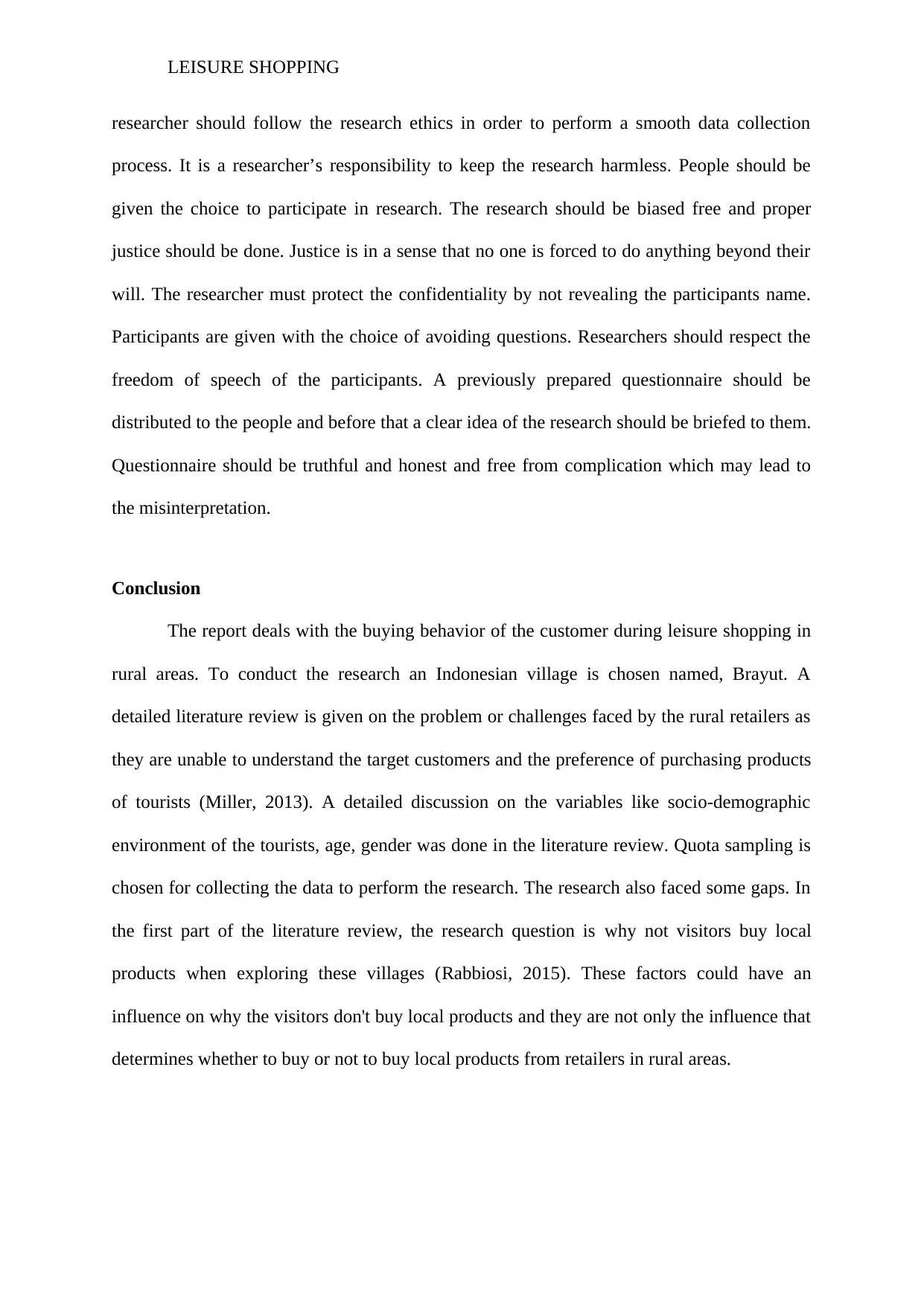
LEISURE SHOPPING
researcher should follow the research ethics in order to perform a smooth data collection
process. It is a researcher’s responsibility to keep the research harmless. People should be
given the choice to participate in research. The research should be biased free and proper
justice should be done. Justice is in a sense that no one is forced to do anything beyond their
will. The researcher must protect the confidentiality by not revealing the participants name.
Participants are given with the choice of avoiding questions. Researchers should respect the
freedom of speech of the participants. A previously prepared questionnaire should be
distributed to the people and before that a clear idea of the research should be briefed to them.
Questionnaire should be truthful and honest and free from complication which may lead to
the misinterpretation.
Conclusion
The report deals with the buying behavior of the customer during leisure shopping in
rural areas. To conduct the research an Indonesian village is chosen named, Brayut. A
detailed literature review is given on the problem or challenges faced by the rural retailers as
they are unable to understand the target customers and the preference of purchasing products
of tourists (Miller, 2013). A detailed discussion on the variables like socio-demographic
environment of the tourists, age, gender was done in the literature review. Quota sampling is
chosen for collecting the data to perform the research. The research also faced some gaps. In
the first part of the literature review, the research question is why not visitors buy local
products when exploring these villages (Rabbiosi, 2015). These factors could have an
influence on why the visitors don't buy local products and they are not only the influence that
determines whether to buy or not to buy local products from retailers in rural areas.
researcher should follow the research ethics in order to perform a smooth data collection
process. It is a researcher’s responsibility to keep the research harmless. People should be
given the choice to participate in research. The research should be biased free and proper
justice should be done. Justice is in a sense that no one is forced to do anything beyond their
will. The researcher must protect the confidentiality by not revealing the participants name.
Participants are given with the choice of avoiding questions. Researchers should respect the
freedom of speech of the participants. A previously prepared questionnaire should be
distributed to the people and before that a clear idea of the research should be briefed to them.
Questionnaire should be truthful and honest and free from complication which may lead to
the misinterpretation.
Conclusion
The report deals with the buying behavior of the customer during leisure shopping in
rural areas. To conduct the research an Indonesian village is chosen named, Brayut. A
detailed literature review is given on the problem or challenges faced by the rural retailers as
they are unable to understand the target customers and the preference of purchasing products
of tourists (Miller, 2013). A detailed discussion on the variables like socio-demographic
environment of the tourists, age, gender was done in the literature review. Quota sampling is
chosen for collecting the data to perform the research. The research also faced some gaps. In
the first part of the literature review, the research question is why not visitors buy local
products when exploring these villages (Rabbiosi, 2015). These factors could have an
influence on why the visitors don't buy local products and they are not only the influence that
determines whether to buy or not to buy local products from retailers in rural areas.
⊘ This is a preview!⊘
Do you want full access?
Subscribe today to unlock all pages.

Trusted by 1+ million students worldwide
1 out of 15
Related Documents
Your All-in-One AI-Powered Toolkit for Academic Success.
+13062052269
info@desklib.com
Available 24*7 on WhatsApp / Email
![[object Object]](/_next/static/media/star-bottom.7253800d.svg)
Unlock your academic potential
Copyright © 2020–2025 A2Z Services. All Rights Reserved. Developed and managed by ZUCOL.





